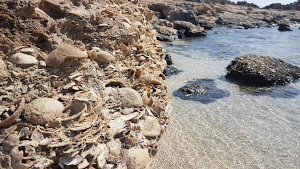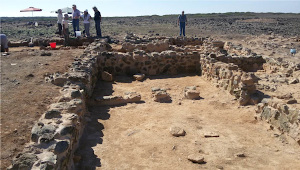 History notes
History notes
The first information about the island come from travellers of Crete. Stasiasmus mentions that "... Ierapetra has an island named Chrissi which has a port and water...".Buondelmonti (in 1415) mentions that Chrissi is "...a flat and almost uncultivated island, beautiful, with hermits and lentisks and cedars...".Raulin after his tour in Crete in 1847 mentions that "...they were sending flocks and salt-pans existed there until 1840..."
The last ages Chrissi is practically uninhabited, while a long time ago there were small settlements. At the west and east part of the island, there are interspersed shells, which show that activity existed there from the Minoan era. The man's harmonic coexistance with the natural environment of the island, kept its natural functions unaffected until today.
 Recent archaeological excavations have brought to light buildings in the northwest side and artifacts that reveal human activity in the Minoan era, where people seem to be involved with fishing and processing shells to make the dye called Royal Purple.
Recent archaeological excavations have brought to light buildings in the northwest side and artifacts that reveal human activity in the Minoan era, where people seem to be involved with fishing and processing shells to make the dye called Royal Purple.
In the northwest part there is the church of Saint-Nikolas, built probably the 13th century. Northeast of the church and near the coast there is an old salt-pan and a house built on ancient facilities which include a small construction (Spilio) and a small break-water. In the wider area there are remnants of large rectangular fields bordered by low stone-built yards. In the south and southwest of Saint -Nikolas there are wells and some sculptured graves.The biggest of them is from Roman times.
In the recent years, Chrissi offered and continues to offer lee shores for the area's fishermen to take the fish off their fishing-nets and get rest. Quite a few people also go to the island to gather weeds and wild artichokes. The shepherds of the opposite coast used to transfer sheep there and to the Smallisland during the winter, while partridges, hares and rabbits were imported. The owners of the restaurants which existed in the island the old days but also several summer visitors planted plant species which did not formerly exist in the island such as bouzi(ice plant), athanatos ( agaves ) and armiriki (tamarisk tree ).
Chrissi island ( which means golden island ) was named as shown because of the golden sand. It is inextricably linked with the lives of local residents of the wider area of Ierapetra, who call it just "the island" or other times Gaidouronisi ( which means donkey island ) and for many decades now, is a recreational oasis for them.





